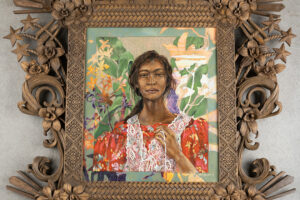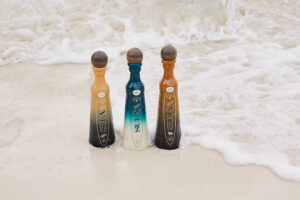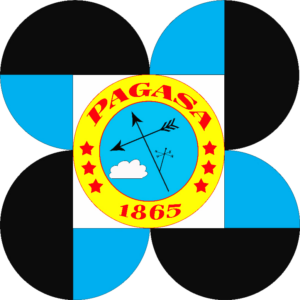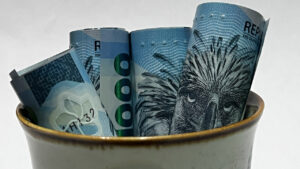IT IS an artist’s dream to capture nature’s awe-inspiring force, sense of mystery, and healing power. At Provenance Gallery, artworks that take a close look at the natural world, made by two longtime friends, are on view.
Vīta, Solenn Heussaff-Bolzico and Olivia d’Aboville’s dual exhibit — also their first time to collaborate despite growing up together — represents different facets of how life and nature are in a constant state of flux. Curated by Stephanie Frondoso, the exhibit highlights their varying odes to humans’ relationship to the natural world: Ms. Heussaff-Bolzico’s colorful, detailed floral paintings and Ms. D’Aboville’s geometric, abstract textile works.
“We installed the show by putting Solenn’s figurative paintings side-by-side with Olivia’s more material works,” Ms. Frondoso pointed out at the exhibit’s media walkthrough on Dec. 10.
While Ms. Heussaff-Bolzico is known as a muralist who explores social realist themes, her artistic breadth expands to include more textured, mixed-media works (utilizing posca pen, acrylic, gel, and oil pastel all in one painting, for example) to depict nature in a way that jives with her friend’s work.
As for Ms. D’Aboville, her expertise lies in playing with contemporary Filipino textiles’ visual complexities and collaborating with local artisans for the handwoven abaca fabric that is pleated and stitched on canvas.
At the exhibit, viewers can see how their art styles are complementary. “We arranged their works interspersed with one another to show dynamism, movement, and the circularity of nature,” Ms. Frondoso told BusinessWorld.
IN CONSTANT FLUXThe exhibit would not have come about if not for the personal growth of each artist in the past five to 10 years, which allowed them to slow down and reconnect, according to Ms. Heussaff-Bolzico.
“We’re both mothers of two, and we both work from home,” she told the press. “At a certain point of your life, you know, you edit people out. And you kind of go back to your roots, to what you’re comfortable with.”
Plants at home serve as a source of inspiration, particularly “how new leaves grow every month and shift to give way for new blades to sprout out.” This constant movement and change can be seen in Ms. Heussaff-Bolzico’s abstract botanical landscapes, profuse with tropical plants like ferns, orchids, and lilies, but depicted in dreamlike colors.
Her monumental, immersive triptych Incipere (coming to existence) looms over the viewer as a forest does. The varying mixed media patterns are able to highlight the fragility of the softest flowers amid the unceasing power of the lush, textured green around them.
Pollentia (might, power), a portrait of a Filipina farmer, is a highlight piece, framed in carved upcycled wood. Ms. Heussaff-Bolzico’s roots in the town of Paete, Laguna, known for its woodworkers, motivated her to commission Charming Baldemor, a carver and niece of local sculptor Fred Baldemor, for the intricate frame.
“I wanted to add a touch of Filipina hands. I designed the frame, but it was carved beautifully by Charming. It took 60 days to carve,” said Ms. Heussaff-Bolzico. The frame has a plethora of symbols — ylang-ylang flower for grace, a farmer’s basket for heritage, and the flag’s three stars and a sun for Filipino pride.
THE ACT OF MAKINGMs. D’Aboville’s textile works reflect similar themes, except her material source — leftover stock fabric of weaving houses — also speaks volumes about sustainability. The textiles are woven in Cebu. In her atelier, the artisans pleat the rolls of fabric, then she creates the design, cutting and juxtaposing the pleats.
“It takes a village; a long process involving many hands,” said the artist. With fine needlework, each pleat is meticulously hand-stitched in the traditional diamond pattern, as if in an ancient script.
Her Sowing series of color field compositions evokes the natural geometry (tessellations) found in nature, in snakeskin, leaf patterns, tree bark. More than 100 yards of handwoven abaca, raffia, and polyester textiles were used for the show.
“These are actually the back of the piece. We pleated the raffia, and I found the knots in the back a lot more interesting than the front. It has this very contemporary feel to it, but also very ethnic, very tribal, and I decided to add pops of yellow to enhance it,” she said of one work.
The methodology of Ms. D’Aboville draws close attention to the act of making. On one hand, they present weaving and sewing as repetitive, meditative actions; on the other, these are gendered crafts previously associated with women’s domestic labor.
TENSION AND HARMONYThe two artists collaborated on pieces that contain both their touches. These are 60” x 48” dialogic works — two massive digital prints on handwoven abaca polyester fabric that is stitched on canvas then combined with acrylic, posca pen, and oil pastel.
Integrating each other’s ideas and aesthetics, the lush, floral images of Ms. Heussaff-Bolzico’s paintings have been digitally printed onto Ms. D’Aboville’s pleated textiles. The images become distorted, partly by the folds, and partly because the abaca weft is slightly lower than the polyester warp, creating the optical illusion of a shifting image when the viewer moves around it.
“Like in nature, things just happen and you can’t control it. If you move left and right or the time of day changes, then you see the intensity and density of the color change,” Ms. D’Aboville said.
The tension and harmony created by the pleated abaca and polyester against the canvas’ flatness invite visitors to go back to the works to see them in a new light. Even with the individual works, looking closely at both the paintings and the textile canvases yields tiny details that represent the undergrowth and overgrowth of nature, and humans’ relationship with it.
“It’s kind of what the exhibit is about. It’s growth, it’s life, it’s change, transformation,” explained Ms. Heussaff-Bolzico. “Basically that’s the process for our works, which both have layers over layers affected by change of emotion, change in day, change of environment.”
Vītais on view throughout December at Provenance Gallery, at the 2nd floor of Shangri-La the Fort, Bonifacio Global City, Taguig. — Brontë H. Lacsamana






